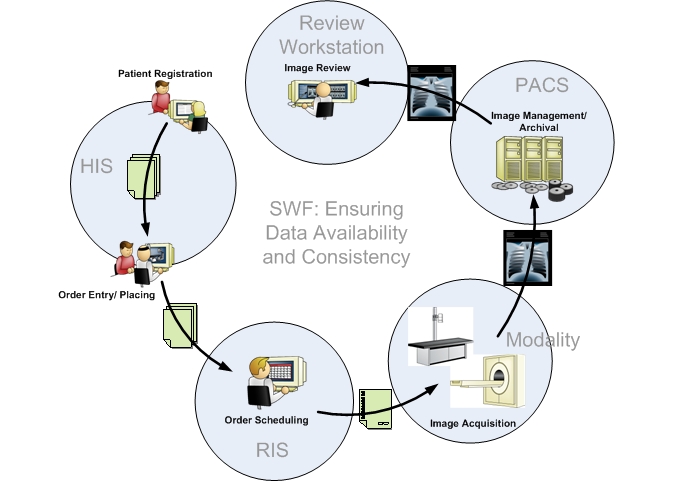Scheduled Workflow
Scheduled Workflow (SWF) integrates the ordering, scheduling, imaging acquisition, storage and viewing activities associated with radiology exams.
Summary
Scheduled Workflow establishes a seamless flow of information that supports efficient patient care workflow in a typical imaging encounter. It specifies transactions that maintain the consistency of patient information from registration through ordering, scheduling, imaging acquisition, storage and viewing. This consistency is also the foundation for subsequent workflow steps, such as reporting.

Benefits
Reduce Errors and Enhance Patient Care
- Prevents manual data entry errors by ensuring that a particular piece of data is entered only once
- Prevents complications from patient allergies or pregnancy status since these details are made available to all systems involved in the radiology workflow
- Prevents delays in patient care by making relevant information available at the point of care.
Improve Throughput
- Saves manual data entry time by ensuring that a particular piece of data is entered only once
- Minimizes "lost" studies by ensuring study identification and status is accurately tracked throughout the department.
- Reduces staff time wasted identifying and correcting errors (in a coordinated fashion) among the HIS, RIS, PACS and modality
Reduce Deployment Cost/Time
- Prevents custom interface specification time and expense—IHE TF provides a detailed specification for a powerful interface, supported and tested by many vendors
- Prevents custom interface implementation time and expense—many IHE Integration Profiles are already supported by many vendor products
- Reduces interface compliance testing time and expense—many implementation variations have been refined in systems tested at IHE Connectathons
- Reduces intersystem testing time and expense—many combinations of systems have already been directly tested together at IHE Connectathons
- Reduces custom interface maintenance time and expense by maintaining a single interface (IHE) instead of multiple custom interfaces
Details
The Scheduled Workflow (SWF) Integration Profile:
- Establishes the continuity and integrity of basic departmental imaging data by profiling specific usage of HL7 messaging across multiple systems including: Patient registration (ADT), Order Placing (CPOE) and Order SCheduling (RIS) systems.
- Bridges the gap between HL7-based systems (like RIS) and DICOM-based systems (like acquisition modalities and PACS) within the radiology department by specifying the semantic mappings between messages.
- Maintains the consistency of patient demographic and ordering information across multiple systems by making that information available to image acquisition modalities via the DICOM Modality Worklist (MWL) Service.
- Ensures that acquired images are not inadvertently lost by specifying that the DICOM Storage Commitment Service is used to transfer the custodianship of images from the modality to the PACS.
- Ensures that the status of acquisition workflow steps are known throughout the department by specifying the use of the DICOM Modality Performed Procedure Step (MPPS) Service to convey that status from the modality to the RIS and the PACS.
Systems Affected
Systems involved in this profile are:
- Enterprise-wide information systems that manage patient registration and services ordering (i.e., admit-discharge-transfer (ADT)/registration system and hospital information system (HIS ))
- Radiology departmental information systems that manage department scheduling (i.e., radiology information system (RIS))
- Radiology image management/archiving (i.e., picture archiving and communication system (PACS))
- Acquisition modalities
Actors & Transactions:
Specification
Profile Status: Final Text
Documents: IHE Radiology Technical Framework:
Underlying Standards:
See Also
Related Profiles
- Patient Information Reconciliation [PIR] extends the capability of SWF by handling cases of unidentified (e.g. trauma), or misidentified patients.
- Cardiac Cath Workflow [CATH] - uses many of the mechanisms of SWF to integrate ordering, scheduling, imaging acquisition, storage and viewing for Cardiac Catheterization procedures.
- Echocardiography Workflow [ECHO] - uses many of the mechanisms of SWF to integrate ordering, scheduling, imaging acquisition, storage and viewing for digital echocardiography
- There are a a number of "content profiles" describing the details of creating and storing various types of image or image related objects, and frequently they would be created in the context of SWF. These content profiles include:
- Nuclear Medicine Image [NM] specifies how Nuclear Medicine images and result screens are created, exchanged, used and displayed.
- Mammography Image [MAMMO] specifies how Mammography images and evidence objects are created, exchanged, used and displayed.
- Evidence Documents [ED] specifies how data objects such as digital measurements are created, exchanged, and used.
- Key Image Note [KIN] lets users flag images as significant (e.g. for referring, for surgery, etc.) and add notes.
Consumer Information
The Scheduled Workflow FAQ answers typical questions about what the Profile does.
Scheduled Workflow Purchasing describes considerations when purchasing equipment to deploy this Profile.
Implementer Information
Scheduled Workflow Implementation provides additional information about implementing this Profile in software.
Reference Articles
- ACR–AAPM–SIIM Technical Standard for Electronic Practice of Medical Imaging. J.T. Norweck, et al., SIIM & ACR Publication, Sept. 2012
- Considerations for Setting Up an Order Entry System for Nuclear Medicine Tests, Hara, Narihiro, et al., Journal of Nuclear Medicine Technology, 2007, Vol. 35, Num. 4, pp 259-271
- IHE technical framework and its application (Article in Chinese), Feng JY, et al., Chinese Journal of Medical Instrumentation, 2005, May, Vol. 29, Num. 3, pp. 199-201
- Using the IHE Scheduled Work Flow Integration Profile to Drive Modality Efficiency, Moore, Stephen M., 2003, Radiographics, Vol. 23, pp 523-529
This page is based on the Profile Template